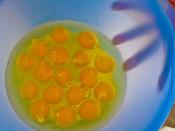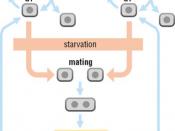DNA directs a cell's activities and determines a cell's characteristic. This vast amount of vital information encoded in DNA is organized into genes. A gene is a segment of DNA that transmits information from parent to offspring. When a cell prepares to divide, the DNA molecule coils and twists into a dense structure called a chromosome. A chromosome is a rod-shaped structure that forms when a single DNA molecule and its associated proteins coil tightly before cell division.
Chromosomes become visible through a microscope only after they have condensed prior to cell division. By this time, each chromosome has formed a copy of itself. The two copies of each are called chromatids. The two chromatids are attached by a protein disk at a point called a centromere.
Human cells have 23 different chromosomes. Your body cells (also called somatic cells) contain two copies of each chromosome, for a total of 46 chromosomes.
The two copies of each chromosome are called homologous chromosomes, or homologues. Homologous chromosomes are similar in shape and size and have similar genetic information. You received one homologue of each chromosome from your mother and the other homologue from your father. When a cell contains two homologues of each chromosome, it is termed diploid.
Not all cells are diploid. In the life cycle of animals, including humans, gametes - egg cells and sperm cells - are haploid. A haploid cell contains only one homologue of each chromosome. The fusion of two haploid gametes forms a diploid zygote. A zygote is a fertilized egg cell, the first cell of a new individual. Being haploid ensures that when an egg and a sperm fuse, the resulting zygote will contain the characteristic diploid number of chromosomes for that organism.
In most cases, humans who are missing even one chromosome...



Valuable contribution
I must commend you ccmustangs2001 on your valuable contributions to cheathouse.com
Your notes are always informative, detailed, thorough and well written.
Keep up the good work.
0 out of 0 people found this comment useful.